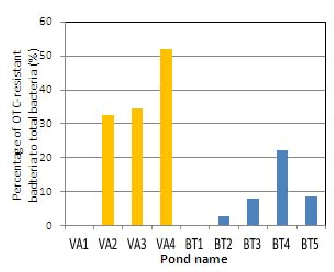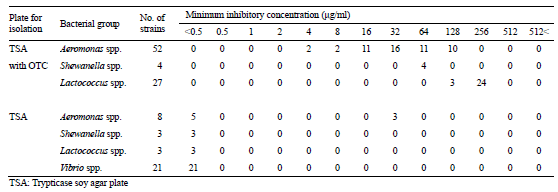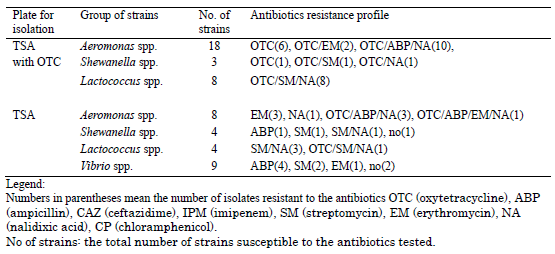Diversity and characterization of oxytetracycline-resistant bacteria associated with white-leg shrimp and giant tiger shrimp which are intensively cultured in Thailand
Description
Shrimp is a globally popular seafood and is traded worldwide. Significant increase in demand has encouraged the aquaculture industry in the developing countries of South Asia and Latin America, and world production reached almost 3.3 million metric tonnes in 2007, with exports exceeding US$14 billion in that year (FAO, 2007). Thailand is one of the major producers of shrimp and is the largest exporter in the world (Tanticharoen et al., 2008). Shrimps in aquaculture are intensively grown and vulnerable to various infectious diseases. Hence, antibiotics are used extensively as therapeutic and prophylactic agents in shrimp cultures. This use has increased the antibiotic resistance of shrimp pathogens, as has also occurred in fish farming. Oxytetracycline is frequently used as a therapeutic and prophylactic agent in aquaculture industries, and many studies have reported OTC resistance in fish pathogens (Aoki et al., 1974; Chopra and Roberts, 2001). Few studies, however, have investigated the prevalence of drug resistance in commensal bacteria associated with cultured fish and shrimps, including those species related to human pathogens (Schmidt et al., 2000, Boinapally and Jiang, 2007). Our previous studies found that live cultured shrimps sold at markets often contain high levels of bacteria including human pathogens (Yano et al., 2004; Yano et al., 2006).
Black tiger shrimp, a native species, was farmed intensively for several decades in Thailand. During the early 2000s, the white-leg shrimp, native to Latin America, was transferred to shrimp industries in Thailand following a decrease of black tiger shrimp culture due to infectious disease (Szuster, 2006). Currently, white-leg shrimp accounts for 98% of the total shrimp production entering the shrimp auction in this area, although black tiger shrimps are still cultured on a small scale (Wyban, 2007). Little is known about the commensal bacteria and their possible drug resistance in either the newly transported shrimp species, or in the endemic black tiger shrimps. This study aimed to survey the prevalence of oxytetracycline (OTC)-resistant bacteria in the white-leg shrimp Litopenaeus vannamei (a non-native species), and the black tiger shrimp Penaeus monodon (a native species), intensively cultured in Thailand.
We investigated the phylogenetic diversity of the OTC-resistant bacterial isolates, as well as the minimum inhibitory concentration (MIC) of OTC, the occurrence of major OTC-resistant genes and multiple antibiotic resistance in the isolates. Shrimps were collected and plated on Tryptic soy agar supplemented with or without oxytetracycline. Percentages of OTC-resistant bacteria were 0.3–52.1% in white-leg samples, and 0.008–22.3% in black tiger samples. Analyses of 16S rDNA sequences indicated that most OTC-resistant isolates were closely related to Aeromonas spp,, Shewanella spp., and Lactococcus garvieae. MICs of OTC were 4–128 µg/ml in the OTC-resistant Aeromonas, and 128–256 µg/ml in OTC-resistant L. garvieae. OTC resistance was found to be conferred by the genes tet(A), tet(C), tet(D), tet(E), tet(M), and tet(S), detected either singly or in pairs. No resistance to ceftazidime, imipenem or chloramphenicol was observed in any isolate. Both species of shrimp are associated with OTC-resistant bacteria at high densities (occasionally exceeding 106 cfu/g). The associated bacteria, predominantly Lactococcus and Aeromonas genera, are potential pathogens, and are reservoirs of a variety of OTC-resistant genes.
Figure, table
-
Fig. 1.Ratio of viable counts of oxytetracycline (OTC)-resistant bacteria to total bacteria associated with shrimps intensively cultured at brackish water ponds in Thailand.
VA1-4: White leg shrimp (L. vannamei) ponds
BT1-5: Black tiger shrimp (P. monodon) ponds -
Table 1. Minimum inhibitory concentration of oxytetracycline (OTC) to bacterial isolates using Tryptic soy agar with and without OTC from intensively cultured shrimps in Thailand
-
Table 2. Multiple antibiotic resistance profile of OTC-resistant isolates from intensively cultured shrimp in Thailand
- Affiliation
-
Japan International Research Center for Agricultural Sciences Fisheries Division
- Classification
-
Research B
- Term of research
-
FY2006~2010
- Responsible researcher
-
YANO Yutaka ( Fisheries Research Agency )
SATOMI Masataka ( Fisheries Research Agency )
HAMANO Kaoru ( Fisheries Division )
Tsutsui Isao ( Fisheries Division )
KAKEN Researcher No.: 80425529Aue-umneoy Dusit ( King Mongkut's Institute of Technology Ladkrabang )
- ほか
- Publication, etc.
-
Yano et al. (2011) Journal of Applied Microbiology, 110(3):713-722.
- Japanese PDF



